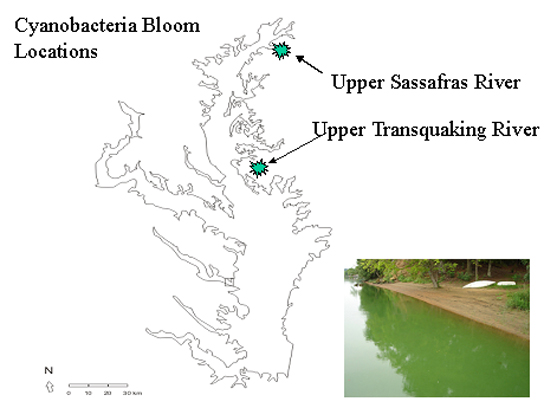Transquaking River, Dorchester County.
On August 31st, Maryland Department of the Environment reported a bloom of blue-green algae (cyanobacteria) extending over a 5-mile stretch of water from Higgins Millpond downstream to Decoursey Bridge. Elevated concentrations of Microcystis, Anabaena and Oscillatoria, possibly toxic cyanobacteria, were identified at Drawbridge Road (Transquaking Bridge) and the Decoursey Road bridge (Table 1). The region is located approximately 10 miles east of Cambridge.
Table 1. Results from August 31st: Cyanobacteria concentrations from samples collected from the
Transquaking River at Transquaking Bridge on Drawbridge Road and Decoursey Road
locations. Upper Sassafras River, Cecil and Kent Counties.
Elevated concentrations of blue-green algae have also been observed on the upper Sassafras River waters bordering Cecil and Kent Counties. The bloom was observed throughout August and the most recent three samples collected on August 23rd by Maryland Department of Natural Resources were dominated by potentially toxic cyanobacteria, such as Anabaena sp. (12,720 to 46,640 cells per milliliter), Anabaenopsis sp. (265 cells per milliliter), Aphanizomenon sp. (47,700 to 62,673 cells per milliliter), and Microcystis sp. (424 to 5,300 cells per milliliter). Other blue-green algae that were abundant in the community were Lyngbya sp. (26,500 to 90,100 cells per milliliter) and Oscillatoria sp. (3 million to 4 million cells per milliliter).
 |
Photo courtesy of John Vail, Sassafras River Association |
Citizens should take common precautions to reduce the risk of illness or discomfort related to blue-green algal blooms.
- The public should not swim in areas where a blue-green algae bloom is evident. Do not drink water from any area with the appearance of a blue-green algae bloom.
- If contact is made with problem water, simply wash off with fresh water.
In some cases, skin irritations may occur after prolonged contact. If irritations persist, see a physician or local health care provider.
- Keep pets and livestock away from bloom areas.
Blue-green algal blooms may contain toxins that could be harmful or fatal to pets and livestock.
- Do not eat viscera (internal organs) of fish caught in blue-green bloom waters.
- Inhalation exposure to blue-green algal bloom waters may result in irritation of the eyes, ears, nose and throat with extended recreational activity on such waterways.
Please note that illness associated with harmful algal blooms is now a reportable illness so physicians should be reporting these to local health departments. The MD DNR, in coordination and cooperation with DHMH and MDE, will continue to monitor all blue-green algal blooms throughout the state. For up to date information on all of Maryland's harmful algal blooms and water quality, please visit Eyes on the Bay
The Chesapeake Bay Safety and Environmental Hotline is a toll-free phone number for Maryland citizens to call to report a problem on the tidal portions of Marylands portion of the Chesapeake Bay, as well as the Coastal Bays. One phone call will now direct citizens to the appropriate agency to make a report 24 hours a day, 7 days a week.
Effective immediately, 1-877-224-7229 will allow citizens to report any of the following:
- Boating accident or reckless activity
- Fish kill or algal bloom
- Floating debris that poses a hazard to navigation
- Illegal fishing activity
- Public sewer leak or overflow
- Oil or hazardous material spill
- Critical area or wetlands violation
- Suspicious or unusual activity
|


